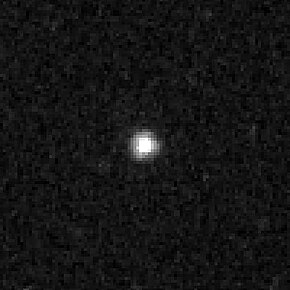(469372) 2001 QF298
 2001 QF298 imaged by the Hubble Space Telescope in 2006. | |
| Discovery[1] | |
|---|---|
| Discovered by | Marc W. Buie[2] Cerro Tololo (807) |
| Discovery date | August 19, 2001 |
| Designations | |
| 2001 QF298 | |
| none | |
| TNO[3] · plutino[4][5] | |
| Orbital characteristics[3] | |
| Epoch 13 January 2016 (JD 2457400.5) | |
| Uncertainty parameter 3 | |
| Observation arc | 4526 days (12.39 yr) |
| Aphelion | 43.726 AU (6.5413 Tm) |
| Perihelion | 34.756 AU (5.1994 Tm) |
| 39.241 AU (5.8704 Tm) | |
| Eccentricity | 0.11429 |
| 245.82 yr (89784.4 d) | |
Average orbital speed | 4.73 km/s |
| 154.29° | |
| 0° 0m 14.435s /day | |
| Inclination | 22.408° |
| 164.24° | |
| 41.215° | |
| Physical characteristics | |
| Dimensions | 408.2+40.2 −44.9 km[6] |
| 0.071+0.020 −0.014[6] | |
| B−V=0.67 ± 0.07 V−R=0.39 ± 0.06[6] | |
| 5.43 ± 0.07,[6] 5.2[3] | |
(469372) 2001 QF298, provisionally known as 2001 QF298, is a resonant trans-Neptunian object that resides in the Kuiper belt in the outermost region of the Solar System.[6] It was discovered on August 19, 2001 by Marc W. Buie.[2] 2001 QF298 is a plutino, meaning that it is locked in a 3:2 orbital resonance with Neptune, much like Pluto.[6]
Physical characteristics
[edit]In 2012, the size of 2001 QF298 was estimated based on thermal radiation data obtained with the Herschel Space Telescope. The result was 408.2+40.2
−44.9 km.[6]
In the visible light, the object appears to have a neutral or slightly red color.[7]
Dwarf planet candidate
[edit]When first discovered, 2001 QF298 was calculated to have an absolute magnitude (H) of 4.7.[1] Light-curve-amplitude analysis from 2008 showed only small deviations, which suggested that 2001 QF298 could be a spheroid about 480 kilometres (300 mi) in diameter with small albedo spots and hence a dwarf planet.[8] It is not included in the same authors' list of dwarf-planet candidates from 2010 because, having an absolute magnitude of 5.4 and assumed albedo of 0.1, it would be less than the cut-off size of 450 kilometres (280 mi)[9] (the same criteria as in the first paper).[8]
References
[edit]- ^ a b "MPEC 2001-T54 : 2001 QE298, 2001 QF298, 2001 QG298, 2001 QH298, 2001 QJ298". IAU Minor Planet Center. 13 October 2001. Retrieved 22 May 2012. (K01QT8F)
- ^ a b "List Of Transneptunian Objects". Minor Planet Center. Archived from the original on 19 June 2007. Retrieved 10 May 2012.
- ^ a b c "JPL Small-Body Database Browser: (2001 QF298)" (2009-09-14 last obs (U=4)). Jet Propulsion Laboratory. Retrieved 30 March 2016.
- ^ "MPEC 2006-X45 : Distant Minor Planets". Minor Planet Center & Tamkin Foundation Computer Network. 21 December 2006. Retrieved 24 July 2008.
- ^ Marc W. Buie (12 June 2006). "Orbit Fit and Astrometric record for 01QF298". SwRI (Space Science Department). Archived from the original on 14 February 2012. Retrieved 24 July 2008.
- ^ a b c d e f g Mommert, Michael; Harris, A. W.; Kiss, C.; Pál, A.; Santos-Sanz, P.; Stansberry, J.; Delsanti, A.; Vilenius, E.; Müller, T. G.; Peixinho, N.; Lellouch, E.; Szalai, N.; Henry, F.; Duffard, R.; Fornasier, S.; Hartogh, P.; Mueller, M.; Ortiz, J. L.; Protopapa, S.; Rengel, M.; Thirouin, A. (May 2012). "TNOs are cool: A survey of the trans-Neptunian region—V. Physical characterization of 18 Plutinos using Herschel-PACS observations". Astronomy & Astrophysics. 541: A93. arXiv:1202.3657. Bibcode:2012A&A...541A..93M. doi:10.1051/0004-6361/201118562.
- ^ Doressoundiram, A.; Peixinho, N.; Moullet, A.; Fornasier, S.; Barucci, M. A.; Beuzit, J. -L.; Veillet, C. (2007). "The Meudon Multicolor Survey (2MS) of Centaurs and Trans-Neptunian Objects: From Visible to Infrared Colors". The Astronomical Journal. 134 (6): 2186. Bibcode:2007AJ....134.2186D. doi:10.1086/522783.
- ^ a b Tancredi, G., & Favre, S. (2008) Which are the dwarfs in the Solar System?. Depto. Astronomía, Fac. Ciencias, Montevideo, Uruguay; Observatorio Astronómico Los Molinos, MEC, Uruguay. Retrieved 10-08-2011
- ^ Tancredi, G. (2010). "Physical and dynamical characteristics of icy "dwarf planets" (plutoids)". Icy Bodies of the Solar System: Proceedings IAU Symposium No. 263, 2009. 263: 173. Bibcode:2010IAUS..263..173T. doi:10.1017/S1743921310001717. S2CID 120558252.
External links
[edit]- (469372) 2001 QF298 at AstDyS-2, Asteroids—Dynamic Site
- (469372) 2001 QF298 at the JPL Small-Body Database
